AI art generators have exploded in popularity over the last few months, but many are on the fence as to whether or not we should embrace this new technology.
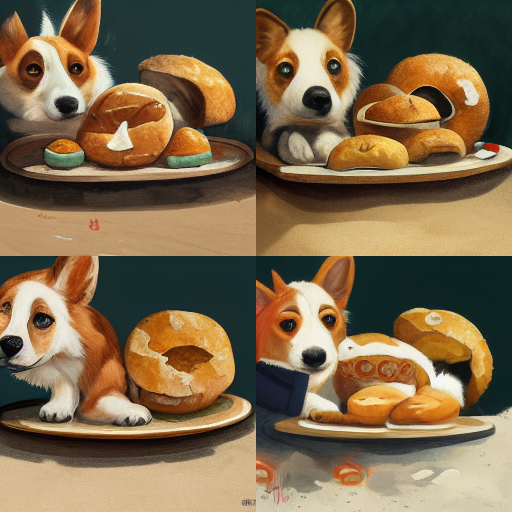
Prompt: A cute corgi sits at a table with a bagel in front of him via Midjourney AI
What is an AI Art Generator?
Text-to-image AI models are a lot of fun for those of us not artistically inclined. Users can enter any word-based prompt, no matter how silly, and receive an original image in a matter of minutes. Depending on various factors, including the specificity of the prompt and the generator used, anything is possible. For instance, a prompt like, “A cute corgi sits at a table with a bagel in front of him,” will produce wonderful, but bizarre images (see above).
These programs are trained on large volumes of existing art and that data is used to create unique, never before seen images. As seen in the image above, the results from this large data gathering aren’t always perfect, but it’s pretty impressive how an AI can get close to creating an idea that hasn’t been thought of before.
Perhaps what is most impressive about these programs is their public accessibility. In the last year, we have seen many applications open themselves up to the public, including Stable Diffusion, Midjourney AI, and DALL-E 2. For the first time, the average internet user has access to these powerful creative tools. Putting creative power in the hands of the consumer should be a powerful moment for humanity, so why is the rise of AI so contentious?
The fear of AI art is unfortunately inevitable. Much like how artists disparaged photography when the camera first emerged or how traditional artists deride digital tools like photoshop brushes, artists of today are fighting against the rise of AI-generated images being passed off as art.
AI wins best in show
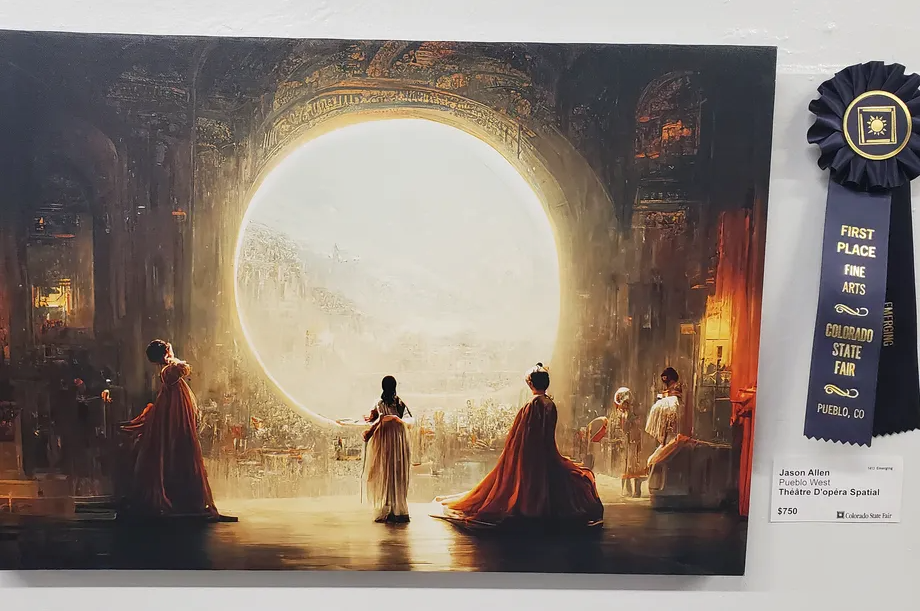
Théâtre D’opéra Spatial by Jason Allen via Discord
In early September, feathers were ruffled when Jason Allen took home the first place blue ribbon for digital art at the Colorado State Fair. His piece, Théâtre D’opéra Spatial, wowed the judges, who were unaware that the piece was generated using Midjourney AI. The subsequent backlash was predictable, with artists lambasting Allen and accusing him of cheating. Allen’s bold taunts toward artists that proclaimed, “Art is dead, dude. It’s over. AI won. Humans lost,” certainly only help to fan the fears that humanity is on a speedrun to a dystopian wasteland.
Beyond the claims that AI-generated art is soulless and lacks humanity, many critics believe that the true problem with the application dwells in its origin–the millions of images sourced from the Internet used to train artificial intelligence. These images are fed to an algorithm in order to train it to recognize patterns, styles, and details. This, to many, is akin to art theft.
Is it inspiration or theft?
In apps like Midjourney, users can use the names of specific artists to finetune prompts. “In the style of Van Gogh, Picasso, and Michaelangelo,” are some famous names used to create works that bring those dead artists back to life. Some modern artists, however, aren’t so keen to see their name climb up the ranks to join them.
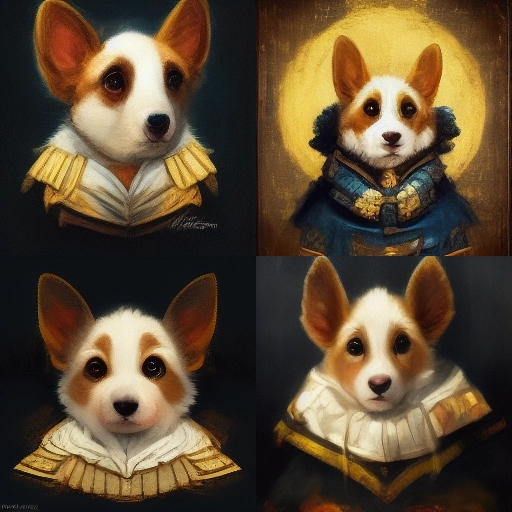
Prompt: A cute corgi in the style of Rembrandt via Midjourney AI
An article by MIT Technology Review details the case of one successful Polish artist, Greg Rutkowski, whose name has climbed up the search ranks as an inspiration for generative art, above the aforementioned greats. Some of the AI-generated art is so impressive, it wouldn’t look out of place in Rutkowski’s own portfolio. “‘It’s been just a month. What about in a year? I probably won’t be able to find my work out there because [the internet] will be flooded with AI art. That’s concerning,’” says Rutkowski.
It’s clear that for Rutkowski, AI is a threat to his livelihood. Other artists who primarily rely on an online audience are facing similar issues. They were never given the option to opt-in or opt-out and currently have no means to fight against these tech companies that are utilizing their creative work for machine-learning
Where do we go from here?
Despite the growing number of protests from many people concerned about ethics, it’s clear that, at least for now, text-to-image software is here to stay. Midjourney has over a million users alone on discord, along with 46,000 users on the r/Midjourney subreddit. On TikTok, hashtags like #dalle2, #midjourney, #stablediffusion, and #aiart have amassed millions of views, and we can see similar viewership on YouTube. The novelty of creating a fully realized image in a matter of seconds is exploding. So how will this new technology affect us? Below are three predictions for the possible future of AI-generated art.
Our understanding of copyright and intellectual property will forcibly change, as well as how artists protect their work.
We have already discussed the potential harm AI is having on artists. While it’s unlikely legality will stop large tech companies, expect to see the conversation surrounding the ethics of this technology grow. There will be calls for new legislature to be written as well as amendments to existing copyright laws.
Some artists will also be more hesitant to share their work online. Melissa Heikkilä, MIT Technology Review’s lead AI writer, suggests that “[t]he art community could end up moving into a pay-per-play or subscription model like the one used in the film and music industries.” We can already see this in action with how some artists lock certain artwork behind Patreons, but soon, they may move all of their work to a pay-only model. However, it’s uncertain whether this model will help artists or push the average person more towards AI.
Corporations and small businesses will begin to invest heavily in AI Art
This year, with nearly every article proclaiming generative art to be the next big thing, we are already seeing corporations take advantage: This year, Cosmopolitan released what they called, “The World’s First Artificially Intelligent Magazine Cover.” It featured an image of a pink astronaut casually strutting on Mars, created by OpenAI’s DALL-E 2. Midjourney offers a $600/year corporate membership for companies with over $1 million/year in gross revenue.
The potential is limitless for commercial applications: book covers, album covers, art posters, greeting cards, keychains, rugs, and more. All of the current applications promise free commercial use for any work generated by their AI. We might see companies cutting the cost of hiring artists or paying for stock images and instead have a couple of junior employees tinker around with prompts.
In an effort to stand out, we might also see companies utilizing these programs as design idea farms for clothing, furniture, and housewares. Even those seeking to start their own small business might see success in selling AI-generated art prints on sites like Redbubble and Society6.
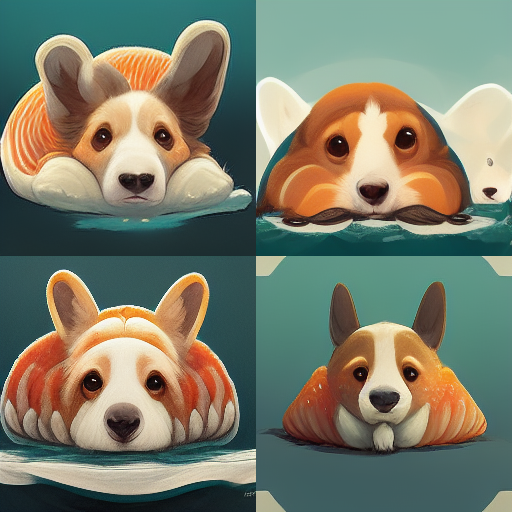
Prompt: A cute corgi riding on the back of a walrus via Midjourney AI
We will begin to see even more creative uses for generative art like graphic novels, animations, and movies.
While researching this topic, I was astonished to see how many writers were attempting entire graphic novels through Midjourney. After spending hours fine-tuning prompts, it’s possible to create a full story with AI. We even have music videos made by AI. Many have no doubt that with the rapid improvement we’re seeing with these applications in just a few months, the time spent finetuning will shorten drastically.
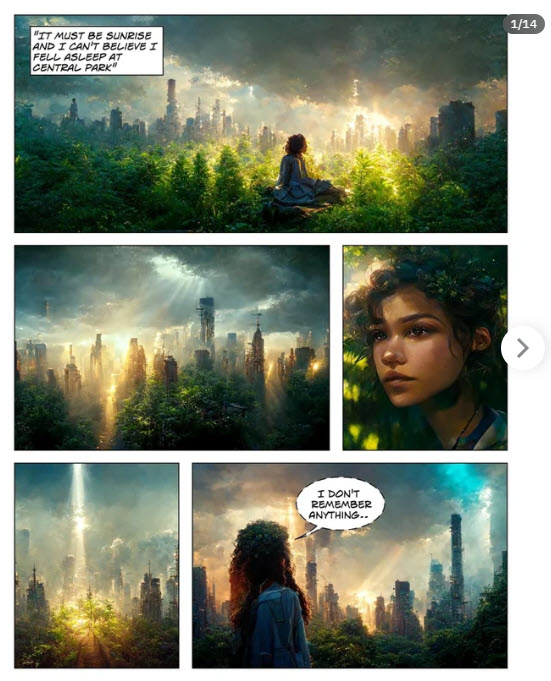
Read the short graphic novel here
With text-to-art taking off, text-to-video is also just getting started. Recently Meta revealed their newest project, Make-A-Video, a generator that produces short videos via text prompts. While not yet available to the public, Meta claims, “the system learns what the world looks like from paired text-image data and how the world moves from video footage with no associated text.”
With Meta’s recent announcement, we can expect to see more companies quickly adopt text-to-video models. It’s possible that in just a couple of years, we will have full movies created based on scripts fed to an AI. Animators might be able to save time by having AI generate scenes. For fans of video games, many are eager to see how this technology can be used to help the output of their favorite indie game developers.
Rather than viewing generative AI as at war with artists, proponents urge artists to see these programs as tools for productivity and creativity.
To be sure, some of these ideas are several years away from reality. But with the advancement we’re seeing now, there’s no doubt that the future will be mind-blowing.
In the meantime, the best way to learn more about generative AI is to play with it yourself. Below is a list of the best text-to-art generators available for free.
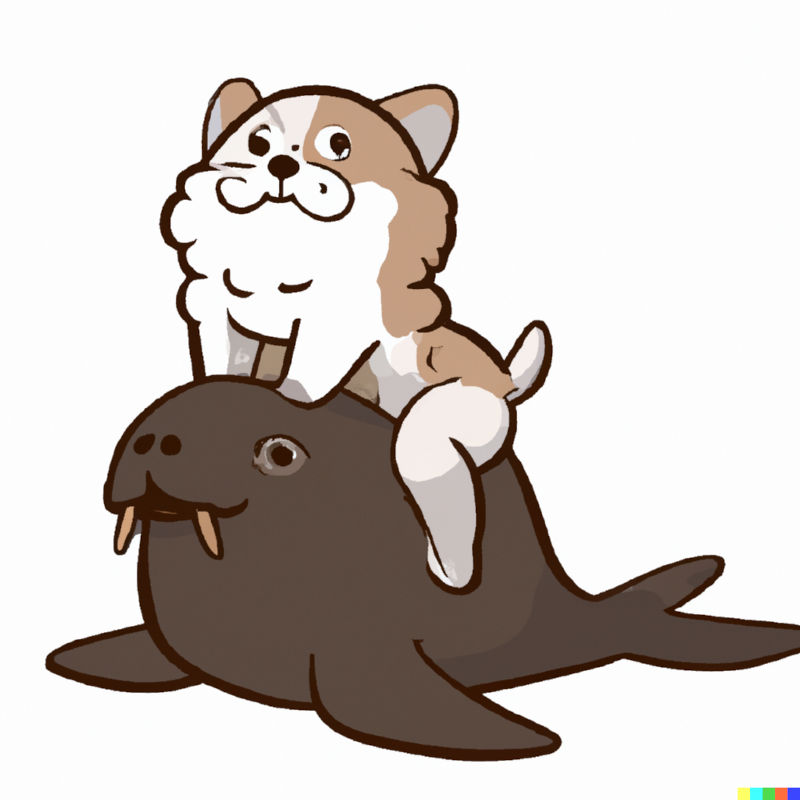
Prompt: A corgi sitting on the back of a walrus via DALL-E 2
Four art generators you can play with right now

Prompt: A happy axolotl holding a sword vis DALL-E 2
This AI generator was developed by OpenAI and just recently opened itself to the public. The name DALL-E is a portmanteau between artist Salvador Dali and the animated Pixar character, WALL–E. DALL-E is recognized for its ability to interpret text prompts (through the use of OpenAI’s GPT-3, a powerful natural language machine learning algorithm) and produce astonishingly realistic images. Users are also able to edit images by feeding them to the generator and asking the AI for simple tasks like, “Make this image sunny,” or, “Add a dog on the bench.”
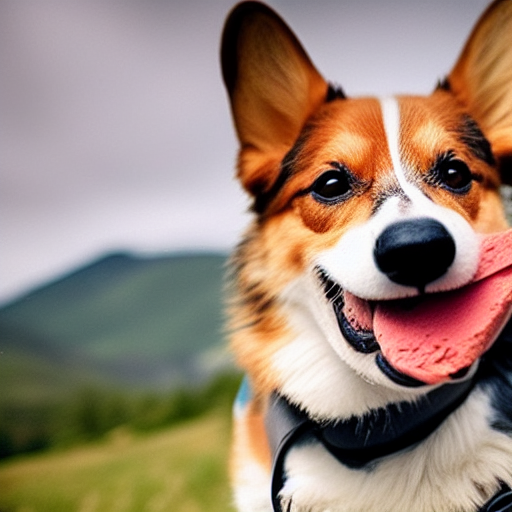
Prompt: a corgi eating a biscuit at a national park via Stable Diffusion
Developed by StabilityAI, Stable Diffusion is another popular option for online users. What makes this option truly unique is StabilityAI’s commitment to transparency. The software behind Stable Diffusion is open software, giving others the opportunity to build and expand on its development. Unlike some other popular software, Stable Diffusion is also able to create hyper-realistic images using celebrities and popular characters.
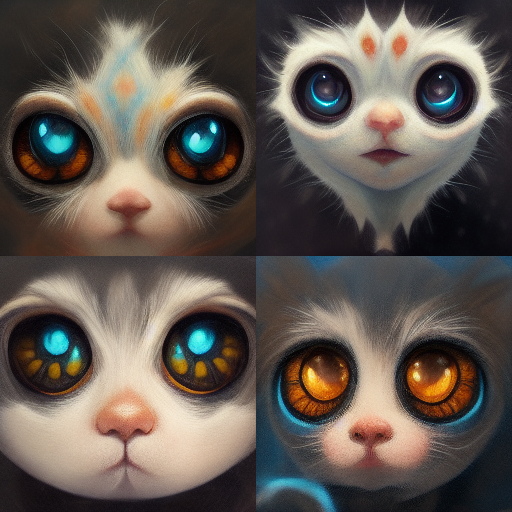
Prompt: cute kitten, large eyes, highly detailed eyes, ethereal via Midjourney AI
Available through discord, Midjourney AI is one of the most well-loved text-to-image generators that launched in July of this year. Midjourney allows users to submit text prompts to a discord bot, which in turn delivers four quality images. Unlike Stable Diffusion and DALL-E 2, the base art style of Midjourney is highly stylized and not focused on photorealism. Therefore, it leans more towards artistic creations. Midjourney is also capable of utilizing celebrity faces and allows users to imagine their favorite public figures in different settings and as new characters.
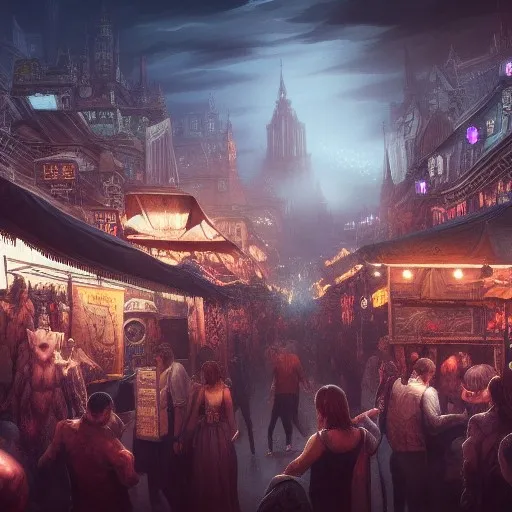
Prompt: A night market filled with supernatural creatures via NightCafe Creator
Founded in 2019, this free text-to-art generator is great for novices who are just dipping their toes into AI art. The easy-to-use interface allows users to create art by writing a simple prompt and picking a style. For more advanced options, you have the option of choosing which algorithm to run your prompt under that will affect the believability of the image. What makes NightCafe unique is that it offers fair pricing for art prints of your creations; prints can be sent to you like a painting.
Frequently Asked Questions
1. Who owns AI art?
Currently, the US Copyright Office has rejected the request to allow an AI to copyright its creations, claiming that AI artwork “lacks the human authorship necessary to support a copyright claim.” What this means is that art generated by AI currently has no ownership. Any art used for personal or commercial gain would not be protected under US law. Experts advise businesses interested in utilizing AI for advertising to be wary of the inevitable legal clashes.
2. What are the benefits of AI art?
Much like a camera or photoshop, artists can use AI art-generators as a supplemental tool. AI is able to help improve speed and accuracy when it comes to producing art, as well as taking over menial and repetitive tasks. WebToon artists have seen increased productivity using 3D models, and AI can work in a similar fashion.
3. Can artists be replaced by AI?
One of the defining factors of human creativity is our ability to create with intent. Currently, text-to-art generators are focused on output, meaning that there is no meaning behind the images produced. An AI cannot create something with a task or concept in mind. Until AI art can create with intention, artists are not in danger of being fully replaced.
- The Rise of Intelligent Websites - February 19, 2025
- Top Trending Products to Boost Your Shopify Store in 2024 - September 4, 2024
- AI Terms Glossary: Key AI Concepts You Should Know - August 22, 2024

